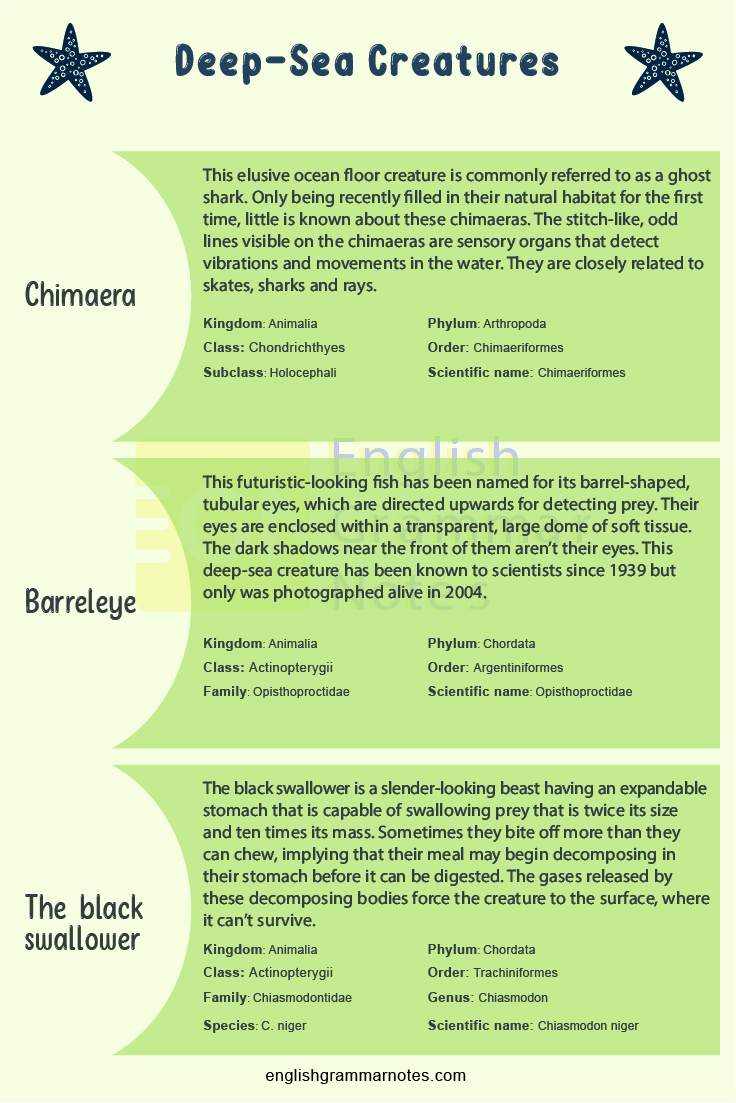Deep Sea Creatures: The sea is a beautiful yet mysterious place filled with deadly creatures living in the depth of the waters. From eyeless to giant sea monsters, these scary sea creatures have found a home in the depths of the sea. Scientists believe that we have discovered only 5% of the ocean of earth. Constantly amazing sea creatures are being found.
In this writing, we have designed a list of deep-sea creatures found in the depths of the oceans surviving in the planet’s most extreme habitats. These terrifying deep-sea creatures have adapted their lifestyles according to their habitat in the deep sea, which we have also discussed in this article.
Study the most important English Vocabulary Words identified by our experts and learn the right vocabulary to use in your day to day conversations
List of Deep-Sea Creatures
Name of Deep-sea Creatures
- Japanese spider crab
- Frilled Shark
- Deep-sea dragonfish
- Goblin Shark
- Vampire squid
- Stargazer
- Colossal squid
- Blue-Ringed Octopus
- Leafy Sea Dragon
- Terrible-claw Lobster
- Fangtooth Fish
- Atlantic wolffish
- Pacific viperfish
- Sea spider
- Giant isopod
- Spiny red crab
- Stareater
- Gulper eel
- Anglerfish
- Chimaera
- Barreleye
- The black swallower
Description of Deep-sea Creatures
Japanese spider crab
If you are afraid of spiders, take a glance at these ghoulish-looking species of marine crab. These marine crabs have the biggest leg span among any invertebrate animals, with a spine-tingling length of around 5.5 meters from claw to claw.
These crabs can also weigh up to 19 kg. They can survive with up to three missing limbs and can grow back these missing limbs during successive moults.
| Kingdom | Animalia |
| Phylum | Arthropoda |
| Subphylum | Crustacea |
| Class | Malacostraca |
| Order | Decapoda |
| Infraorder | Brachyura |
| Family | Inachidae |
| Genus | Macrocheira De Haan; 1839 |
| Species | M. kaempferi |
| Scientific name | Macrocheira kaempferi |
Frilled Shark
The frilled shark is often known as the ‘living fossil’ due to its primitive-looking features. Seldom seen by humans, these species lurk in the oceans Pacific and Atlantic at depths between 120 to 1580 meters.
The jaws of these sharks are lined with 25 rows of trident-shaped backwards-facing teeth. This adds up to 300 razor sharps in total.
| Kingdom | Animalia |
| Phylum | Chordata |
| Class | Chondrichthyes |
| Order | Hexanchiformes |
| Family | Chlamydoselachidae |
| Genus | Chlamydoselachus |
| Species | C. anguineus |
| Scientific name | Chlamydoselachus anguineus |
Deep-sea dragonfish
These ferocious predators lurk at the depths of up to 5,000 meters, deep down in the Atlantic Oceans.
The conditions down at this depth are extreme – there is no plant life, no light, and the environment are entirely still since it is unaffected by ocean currents or storms. To catch prey in these drastic conditions, they use photophores – a light-producing organ – which attacks target into their fang-toothed jaws.
| Kingdom | Animalia |
| Phylum | Chordata |
| Class | Actinopterygii |
| Order | Stomiiformes |
| Family | Stomiidae |
| Genus | Grammatostomias |
| Species | G. flagellibarba |
| Scientific name | Grammatostomias flagellibarba |
Goblin shark
These sharks have been voted as the ugliest and scariest animals in the world. They have a long, pointed snout, as well as a detachable mouth, implying it can be extended for devouring their prey.
Some researchers have shown that these sharks can also dive up to the depths of 1300m for short periods.
| Kingdom | Animalia |
| Phylum | Chordata |
| Class | Chondrichthyes |
| Order | Lamniformes |
| Family | Mitsukurinidae |
| Genus | Mitsukurina |
| Species | M. owstoni |
| Scientific name | Mitsukurina owstoni |
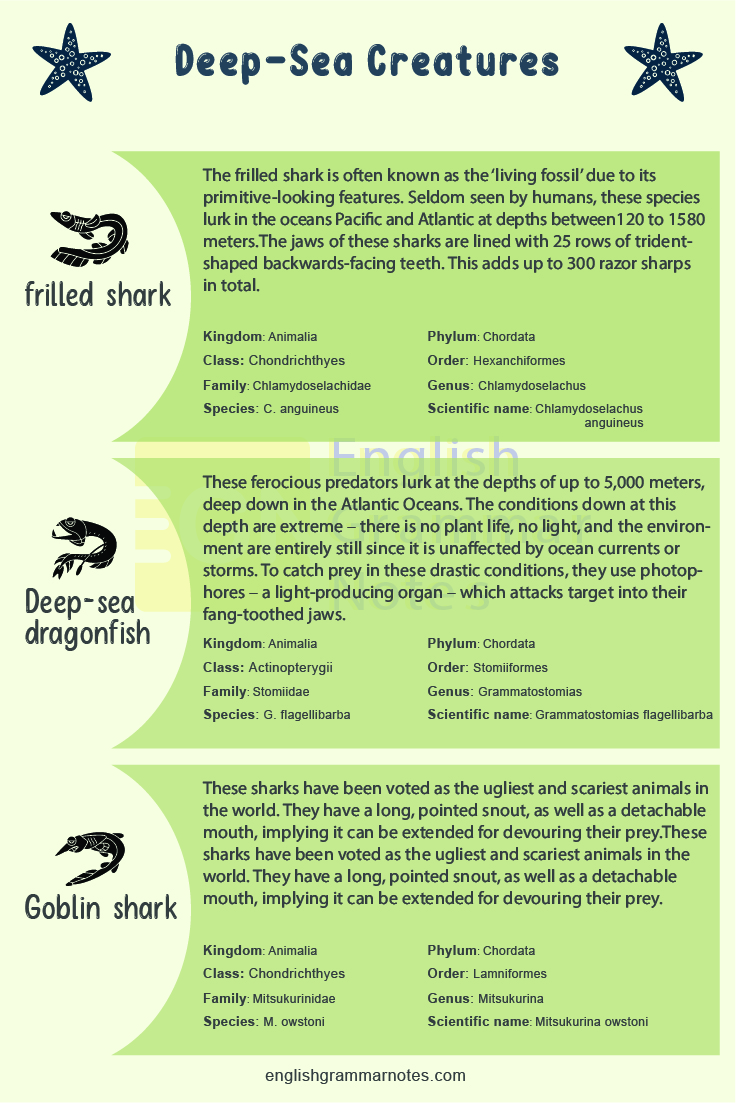
Vampire squid
Not much is known about this mysterious, scarlet-bodied deep-sea creature which is thought to reside at the lightless depth of up to almost 900 meters.
Here the oxygen saturation may be as low as 3%, but these vampire squids can easily thrive in these suffocating conditions. The reddish colour of these squids is not the only reason for their spooky name.
| Kingdom | Animalia |
| Phylum | Mollusca |
| Class | Cephalopoda |
| Order | Vampyromorphida |
| Family | Vampyroteuthidae |
| Genus | Vampyroteuthis Chun; 1903 |
| Species | V. infernalis |
| Scientific name | Vampyroteuthis infernalis |
Stargazer
In spite of the nice name given to this creature, the stargazer has two venomous spines with specific species and can also electrocute its prey. Their eyes face upwards so that they can attack their unsuspecting prey from below.
These fishes are also a delicacy in some countries and can be found in the markets with their electric organ removed.
| Kingdom | Animalia |
| Phylum | Chordata |
| Class | Actinopterygii |
| Order | Trachiniformes |
| Family | Uranoscopidae |
| Genus | Kathetostoma |
| Species | K. nigrofasciatum |
| Scientific name | Kathetostoma nigrofasciatum |
Colossal squid
Currently, scientists have estimated this legendary marine creature has put its maximum size at 12 to 14 meters long. They weigh up to 750 kg. This enormous species has the most prominent eyes documented in the animal kingdom, estimated to be 30 to 40 cm in diameter.
It is believed that the scars on the back of sperm whales have been caused by the hook-like tentacles of the colossal squid.
| Kingdom | Animalia |
| Phylum | Mollusca |
| Class | Cephalopoda |
| Superorder | Decapodiformes |
| Order | Oegopsida |
| Family | Cranchiidae |
| Subfamily | Taoniinae |
| Genus | Mesonychoteuthis; Robson 1925 |
| Species | M. hamiltoni |
| Scientific name | Mesonychoteuthis hamiltoni |
Blue-Ringed Octopus
These blue-ringed octopuses vary in size from 4 to 8 inches, and their bright colours make them look friendly. They don’t look like the usual sea monsters shown on television.
However, one bite from these creatures can easily paralyze any human and also kill them. These creatures are considered to be one of the most poisonous animals in the world.
| Kingdom | Animalia |
| Phylum | Mollusca |
| Class | Cephalopoda |
| Order | Octopoda |
| Family | Octopodidae |
| Genus | Hapalochlaena |
| Scientific name | Hapalochlaena |
Leafy Sea Dragon
Relayed closely to pipefishes, these beautiful deep-sea creatures resemble sea horses and, since they are poor swimmers, have evolved to look similar to aquatic plants to avoid predators.
They are the only members of the genus Phycodurus. They are found along the western and southern coasts of Australia. They get their name because of their appearance – long leaf-like protrusions from all over the body.
| Kingdom | Animalia |
| Phylum | Chordata |
| Class | Actinopterygii |
| Order | Syngnathiformes |
| Family | Syngnathidae |
| Subfamily | Syngnathinae |
| Genus | Phycodurus T. N. Gill; 1896 |
| Species | P. eques |
| Scientific name | Phycodurus eques |
Terrible-claw Lobster
Found in the seas of the Philippines, this creature has been appropriately named lobster, having two terrible-looking claws. These lobsters are also extremely tiny, around the size of 31 millimetres long.
These marine creatures aren’t just small, and they are also blind. This implies that they will probably take a good stab at anything which comes too close to him.
| Kingdom | Animalia |
| Phylum | Arthropoda |
| Subphylum | Crustacea |
| Class | Malacostraca |
| Order | Decapoda |
| Family | Nephropidae |
| Genus | Dinochelus; Ahyong Chan & Bouchet 2010 |
| Species | D. ausubeli |
| Scientific name | Dinochelus ausubeli |
Fangtooth Fish
These menacing creatures are one of the deepest-living fish ever discovered. They have been found as deep as 5,000 meters below sea level, where the pressure underwater is 500 times greater than that of land.
These fishes also hold another title to their name – the largest teeth of any marine species, relative to the size of their body. This makes them unable to close their mouth fully.
| Kingdom | Animalia |
| Phylum | Chordata |
| Class | Actinopterygii |
| Order | Trachichthyiformes |
| Family | Anoplogastridae; T. N. Gill 1893 |
| Genus | Anoplogaster |
| Scientific name | Anoplogaster cornuta |
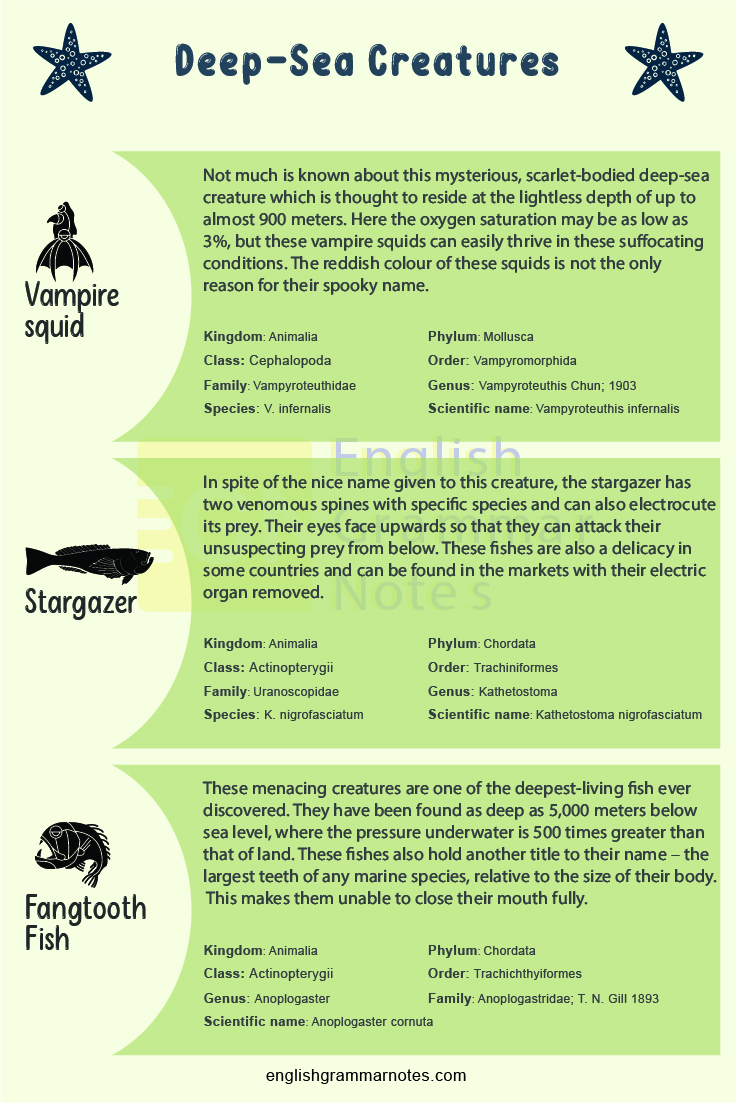
Atlantic wolffish
It is evident where these bottom-dwelling wolffish gets their name from. Having four to six fang-like teeth on their jaws, they also have a further three rows of crushing teeth behind that.
The throat of these marine creatures is scattered with serrated teeth. The eel-like body of these wolffish can reach up to the length of 1.5 meters. The number of these wolffish is rapidly depleting.
| Kingdom | Animalia |
| Phylum | Chordata |
| Class | Actinopterygii |
| Order | Scorpaeniformes |
| Family | Anarhichadidae |
| Genus | Anarhichas |
| Species | A. lupus |
| Scientific name | Anarhichas lupus |
Pacific viperfish
These deep-sea dwellers are the ultimate predator. The viperfish lures the unwilling prey before capturing them in their long, needle-like fangs with the photophore located across their dorsal spine.
The large fangs of these viperfishes are unable to fit inside their mouth. Rather they curl back on the outside, which results in an even more monstrous appearance.
| Kingdom | Animalia |
| Phylum | Chordata |
| Class | Actinopterygii |
| Order | Stomiiformes |
| Family | Stomiidae |
| Genus | Chauliodus |
| Species | C. macouni |
| Scientific name | Chauliodus macouni |
Sea spider
There are almost 1300 known species of sea spiders that lurk in both the shallows and in the deep waters as 7000 meters. Their leg span can range from a small one millimetre to over 25 centimetres. The proboscis of these sea spiders allows them to suck off their prey.
The smaller size is seen in shallow waters, whereas the larger ones are seen in Antarctica and deep waters.
| Kingdom | Animalia |
| Phylum | Arthropoda |
| Subphylum | Chelicerata |
| Class | Pycnogonida; Latreille 1810 |
| Order | Pantopoda; Gerstaecker 1863 |
| Scientific name | Pycnogonida |
Giant isopod
The giant isopods are creepy-looking crustaceans that look similar to the creatures seen in Alien movies. They are usually scavengers but have been known to use their four sets of jaws for feeding on live prey.
They also have seven pairs of legs. Even though the largest species averages between 19 to 36 centimetres, there have also been sightings of 76 centimetres long isopods.
| Kingdom | Animalia |
| Phylum | Arthropoda |
| Subphylum | Crustacea |
| Class | Malacostraca |
| Superorder | Peracarida |
| Order | Isopoda |
| Family | Cirolanidae |
| Genus | Bathynomus |
| Scientific name | Bathynomus |
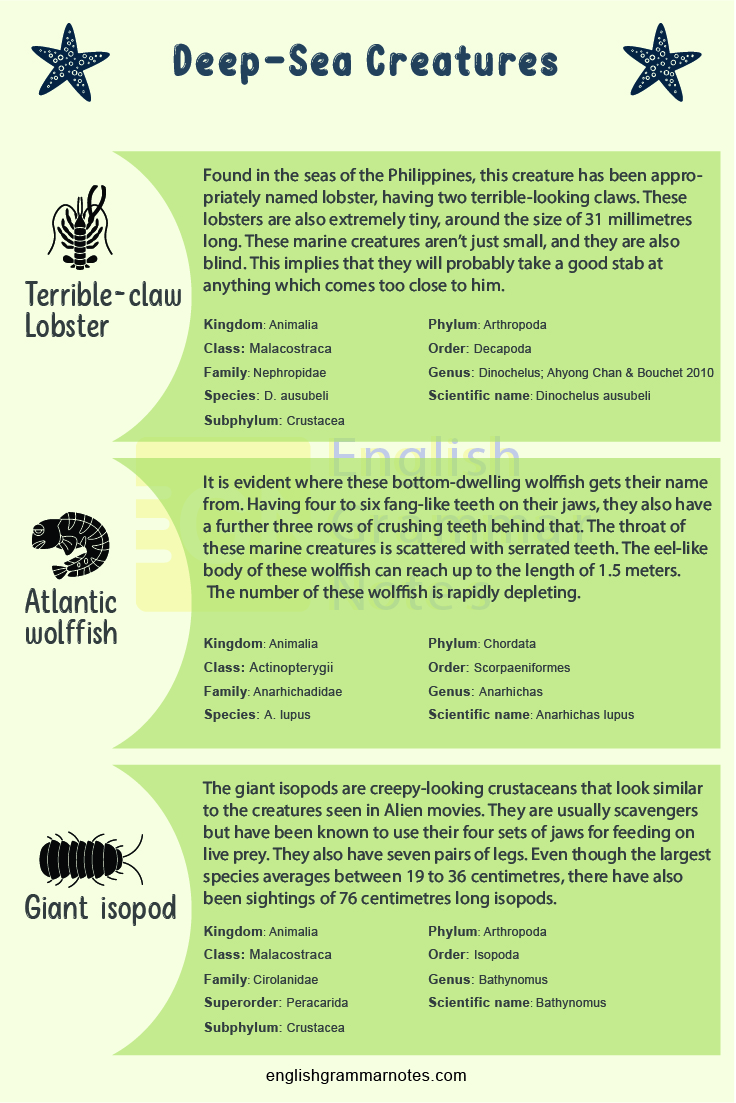
Spider red crab
These spiny red crabs are creeping on the ocean floor depths up to 2,400 meters. Their clutching claws, fast movements, and armoured bodies make it easy for them to get hold of, fear and feast on fresh prey. These crabs’ species are closely related to the hermit crab, with their shell being traded in for some gnarly spikes.
| Kingdom | Animalia |
| Phylum | Arthropoda |
| Subphylum | Crustacea |
| Class | Malacostraca |
| Order | Decapoda |
| Infraorder | Anomura |
| Family | Lithodidae |
| Genus | Lithodes |
| Species | L. Maja |
| Scientific name | Lithodes maja |
Stareater
Recently found in the sea waters between New Zealand and Australia is this aggressive looking fish.
Like several other deep-sea predators, these creatures have a bioluminescent red chin barbel which is used as a lure for attracting small prey. An alternative name of this star eater is snaggletooth, which most likely refers to their sharp, needle-like teeth for catching prey.
| Kingdom | Animalia |
| Phylum | Chordata |
| Class | Actinopterygii |
| Order | Stomiiformes |
| Family | Stomiidae |
| Subfamily | Astronesthinae |
| Genus | Astronesthes |
| Scientific name | Astronesthes |
Gulper eel
Covered in velvety, black skin, this eel-like monster, that resides in the darkness of the ocean at the depths of 3,000 meters below the surface.
The most notable feature of the marine creature is their gulper’s enormous, pouch-like mouth that can be opened wide enough for swallowing a fish much larger than themselves. Its whip-like tail contains numerous tentacles which glow pink and give off occasional bright-red flashes.
| Kingdom | Animalia |
| Phylum | Chordata |
| Class | Actinopterygii |
| Order | Anguilliformes |
| Family | Eurypharyngidae; Gill 1883 |
| Genus | Eurypharynx; Vaillant 1882 |
| Species | E. pelecanoides |
| Scientific name | Eurypharynx pelecanoides |
Anglerfish
These deep-sea creatures’ anglerfish have nightmarish mouths filled with fanged, long teeth. The most common mode of predation is by using a fleshy growth from the head like a fishing lure, waving it back and forth for attracting prey.
The luminescence is due to symbolic bacteria. The bodies and jaws are extremely expandable, meaning it’s able to swallow prey up to twice its size.
| Kingdom | Animalia |
| Phylum | Chordata |
| Class | Actinopterygii |
| Clade | Percomorpha |
| Order | Lophiiformes |
| Scientific name | Lophiiformes |
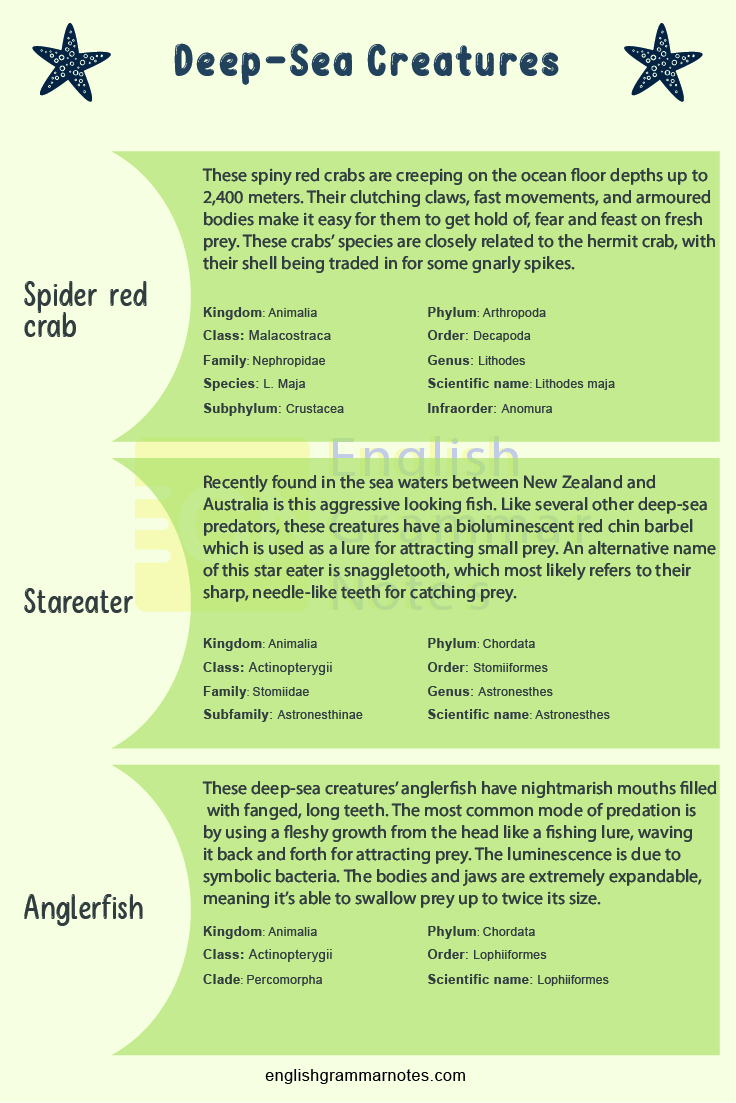
Chimaera
This elusive ocean floor creature is commonly referred to as a ghost shark. Only being recently filled in their natural habitat for the first time, little is known about these chimaeras.
The stitch-like, odd lines visible on the chimaeras are sensory organs that detect vibrations and movements in the water. They are closely related to skates, sharks and rays.
| Kingdom | Animalia |
| Phylum | Chordata |
| Class | Chondrichthyes |
| Subclass | Holocephali |
| Order | Chimaeriformes |
| Scientific name | Chimaeriformes |
Barreleye
This futuristic-looking fish has been named for its barrel-shaped, tubular eyes, which are directed upwards for detecting prey.
Their eyes are enclosed within a transparent, large dome of soft tissue. The dark shadows near the front of them aren’t their eyes. This deep-sea creature has been known to scientists since 1939 but only was photographed alive in 2004.
| Kingdom | Animalia |
| Phylum | Chordata |
| Class | Actinopterygii |
| Order | Argentiniformes |
| Family | Opisthoproctidae |
| Scientific name | Opisthoproctidae |
The black swallower
The black swallower is a slender-looking beast having an expandable stomach that is capable of swallowing prey that is twice its size and ten times its mass. Sometimes they bite off more than they can chew, implying that their meal may begin decomposing in their stomach before it can be digested.
The gases released by these decomposing bodies force the creature to the surface, where it can’t survive.
| Kingdom | Animalia |
| Phylum | Chordata |
| Class | Actinopterygii |
| Order | Trachiniformes |
| Family | Chiasmodontidae |
| Genus | Chiasmodon |
| Species | C. niger |
| Scientific name | Chiasmodon niger |
